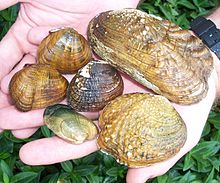Unionidae
| Unionidae | |
|---|---|
 |
|
| Six endangered species of Unionidae | |
| Scientific classification | |
| Kingdom: | Animalia |
| Phylum: | Mollusca |
| Class: | Bivalvia |
| Subclass: | Palaeoheterodonta |
| Order: | Unionoida |
| Family: |
Unionidae Fleming, 1828 |
| Genera | |
|
See text |
|
See text
The Unionidae are a family of freshwater mussels, the largest in the order Unionoida, the bivalve mollusks sometimes known as river mussels, or simply as unionids.
The range of distribution for this family is world-wide. It is at its most diverse in North America, with about 297 recognised taxa, but China and Southeast Asia also support very diverse faunas.
Freshwater mussels occupy a wide range of habitats, but most often occupy lotic waters, i.e. flowing water such as rivers, streams and creeks.
Unionidae burrow into the substrate, with their posterior margins exposed. They pump water through the incurrent aperture, obtaining oxygen and food.
Unionoids remove phytoplankton and zooplankton, as well as suspended bacteria, fungal spores, and dissolved organic matter. Despite extensive laboratory studies, it remains uncertain as to which of these filtrates unionoids actually process. In high densities, they have the ability to influence water clarity but filtration rates are dependent on water temperature, current velocity, and particle size and concentration. In addition, gill morphology can determine particle size filtered, as well as the rate.
Unionidae are distinguished by a unique and complex life cycle. Most unionids are of separate sex, although some species, such as Elliptio complanata, are known to be hermaphroditic.
The sperm is ejected from the mantle cavity through the male’s excurrent aperture and taken into the female's mantle cavity through the incurrent aperture. Fertilised eggs move from the gonads to the gills (marsupia) where they further ripen and metamorph into glochidia, the first larval stage. Mature glochidia are released by the female and then attach to the gills, fins or skin of a host fish. A cyst is quickly formed around the glochidia, and they stay on the fish for several weeks or months before they fall off as juvenile mussels, which then bury themselves in the sediment.
...
Wikipedia
